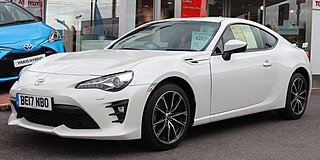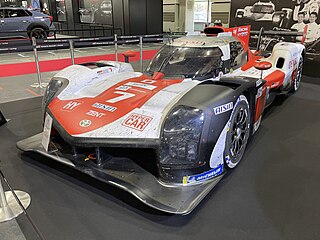
Toyota Racing Development is the in-house tuning shop for all Toyota, Lexus and formerly Scion cars. TRD is responsible both for improving street cars for more performance and supporting Toyota's racing interests around the world. TRD produces various tuning products and accessories, including performance suspension components, superchargers, and wheels. TRD parts are available through Toyota dealers, and are also available as accessories on brand-new Toyotas and Scions. Performance parts for Lexus vehicles are now labeled as F-Sport and performance Lexus models are labeled F to distinguish Lexus's F division from TRD.
Toyota Gazoo Racing Europe GmbH (TGR-E), formerly Andersson Motorsport GmbH and Toyota Motorsport GmbH (TMG), is a fully-owned and controlled entity of Toyota Motor Corporation, based in Cologne, Germany, which provides motorsport and automotive services to fellow Toyota companies and to outside clients, employing around 350 people in a 30,000 m2 factory.

The Toyota iQ is an ultra-compact, front transverse engine, front-wheel-drive city car manufactured by Toyota and marketed in a single generation for Japan (2008–2016); Europe (2008–2015); and North America (2012–2015), where it was marketed as the Scion iQ. A rebadged variant was marketed in Europe as the Aston Martin Cygnet (2009–2013).

The Toyota 86 and the Subaru BRZ are 2+2 sports cars jointly developed by Toyota and Subaru, manufactured at Subaru's Gunma assembly plant.

The Toyota TS030 Hybrid is a Le Mans Prototype 1 (LMP1) sports car built by Toyota Motorsport GmbH and used by the manufacturer in the FIA World Endurance Championship in 2012 and 2013. It was Toyota's first all new prototype since the GT-One last competed in 1999, and was the first petrol-hybrid engine car to participate in the World Endurance Championship. Work on designing the car began in late 2010 when early chassis designs were presented to Toyota Motorsport. The project was stopped briefly after the 2011 Tōhoku earthquake and tsunami, but the car's building was approved six months later. The TS030 Hybrid featured a Kinetic energy recovery system (KERS) regenerative braking device to charge a super capacitor. Its engine, a naturally aspirated petrol 3.4-litre (210 cu in) V8 power unit, was mounted at a 90-degree angle, produced 530 horsepower, and was based on Toyota's Super GT project.

The Toyota TS040 Hybrid is a Le Mans Prototype 1 (LMP1) sports car built and used by Toyota Motorsport GmbH in the 2014 and 2015 seasons of the FIA World Endurance Championship. Work on the car's design began in November 2012, when the Automobile Club de l'Ouest (ACO) published its 2014 technical regulations and Toyota utilised its resources after the 2013 24 Hours of Le Mans. The car is an aerodynamic improvement on its predecessor, the TS030 Hybrid, and its design allowed four-wheel drive. It has two kinetic energy recovery system (KERS) regenerative-braking devices at the front and rear axles to charge a supercapacitor and, in accordance with the 2014 regulations, was placed in the 6 MJ (1.7 kWh) class. The TS040's engine was carried over from the TS030; its displacement was increased from 3.4 l (210 cu in) to 3.7 l (230 cu in) for better efficiency, producing 513 horsepower (383 kW) to the rear wheels.

The Toyota TS050 Hybrid is a sports prototype racing car developed for the 2016 Le Mans Prototype rules in the FIA World Endurance Championship. The car is the direct successor of the Toyota TS040 Hybrid, which competed in both the 2014 and 2015 FIA WEC seasons. The TS050 was revealed at the Circuit Paul Ricard on 24 March 2016 due to Toyota's 2-year cycle policy. The engine is a 2.4L twin-turbocharged petrol V6, while the two previous cars used a naturally aspirated petrol V8. It features an 8-megajoule hybrid system, which uses lithium-ion batteries.

The 2017 FIA World Endurance Championship was the sixth season of the FIA World Endurance Championship, an auto racing series co-organised by the Fédération Internationale de l'Automobile (FIA) and the Automobile Club de l'Ouest (ACO). The series is open to Le Mans Prototypes and grand tourer-style racing cars divided into four categories. The season began at the Silverstone Circuit in April and will end at the Bahrain International Circuit in November, and include the 85th running of the 24 Hours of Le Mans. World championship titles will be awarded to the leading prototype drivers and manufacturers, while for the first time in the World Endurance Championship the leading grand touring drivers and manufacturers will also be awarded a world championship.
The 2021 FIA World Endurance Championship was the ninth season of the FIA World Endurance Championship, an auto racing series organised by the Fédération Internationale de l'Automobile (FIA) and the Automobile Club de l'Ouest (ACO). The series is open to prototype and grand tourer-style racing cars divided into four categories. World Championship titles were awarded to the leading manufacturers and drivers in both the prototype and grand tourer divisions.

Le Mans Hypercars (LMH) are sports prototype race cars used in the Hypercar class of the FIA World Endurance Championship alongside LMDh entries from 2022. The cars will also be used in the GTP class of the IMSA WeatherTech SportsCar Championship from 2023.

An LMDh is a type of sports prototype race car that will be used in the Hypercar class of the FIA World Endurance Championship from 2022, alongside LMH entries. The cars will also be used in the GTP class of the IMSA SportsCar Championship from 2023.

The Toyota GR010 Hybrid is a sports prototype racing car developed for the 2021 Le Mans Hypercar rules in the FIA World Endurance Championship. The car is the successor of the Toyota TS050 Hybrid, which competed in the WEC from 2016 to 2020, achieving 2 double WEC world titles and 3 straight victories at the 24 Hours of Le Mans from 2018 to 2020. The GR010 Hybrid was revealed online on 15 January 2021.

The Toyota R32V and R36V engine family are a series of turbocharged, 3.2-liter and 3.6-liter, 90-degree, four-stroke, V-8, gasoline racing engines, designed, developed and produced by Toyota for sports car racing; between 1988 and 1999. The engines were used in various Toyota sports prototype race cars.

The Toyota RV10 engine is a 72-degree, four-stroke, naturally-aspirated, V10 racing engine, designed, developed and produced by Toyota, for their Toyota TS010 Group C sports prototype race car, between 1991 and 1993.
The 2022 Super GT Series is a motor racing championship based in Japan for grand touring cars. The series is sanctioned by the Japan Automobile Federation (JAF) and run by the GT Association (GTA). It is the thirtieth season of the Japan Automobile Federation Super GT Championship which includes the All Japan Grand Touring Car Championship (JGTC) era and the eighteenth season the series to compete under the Super GT name. It is also the fortieth overall season of a national JAF sportscar championship dating back to the All Japan Sports Prototype Championship.
The Toyota H8909 engine family is a series of twin-turbocharged, four-stroke, 2.4-liter and 3.5-liter, V6 racing engines, made by Toyota Gazoo Racing for use in their TS050 and GR010 Hybrid Le Mans Prototype race cars, since 2016.

The Toyota 87C, also known as the TOM'S 87C, was a Group C prototype sports car, designed, developed and built by Toyota, for use in sports car racing, specifcally the World Sportscar Championship, between 1987 and 1988.
The Dome 86C was a racing prototype, designed, developed and built by Japanese manufacturer Toyota in partnership and collaboration with Japanese constructor Dome and homologated specifically to race in the FIA Group C category of the Fédération Internationale de l'Automobile. It was powered by a turbocharged 4T-GTE four-cylinder engine, developing between 630–670 hp (470–500 kW), depending on boost pressure. It didn't win any races, with its best result being 4th-place finish at Fuji in 1986.

The Dome 85C was a racing prototype, designed, developed and built by Japanese manufacturer Toyota in partnership and collaboration with Japanese constructor Dome and homologated specifically to race in the FIA Group C category of the Fédération Internationale de l'Automobile. It was powered by a 500 hp (370 kW) turbocharged 4T-GTE four-cylinder engine.

The Toyota 91C-V is a Group C sports prototype racing car, developed and built by Toyota intended to participate in the World Sportscar Championship, the 24 Hours of Le Mans, and the All-Japan Japanese Sports-Prototype Championship. It is an evolution of the previous 90C-V. Its powerplant is a turbocharged 3.2–3.6 L (200–220 cu in) Toyota V8 engine, producing 800 hp (600 kW). It won 3 races, achieved 6 podium finishes, and scored 3 pole positions. At a speed of 200 mph (320 km/h), it is capable of producing over 5,000 lbf (22,000 N) of downforce.














